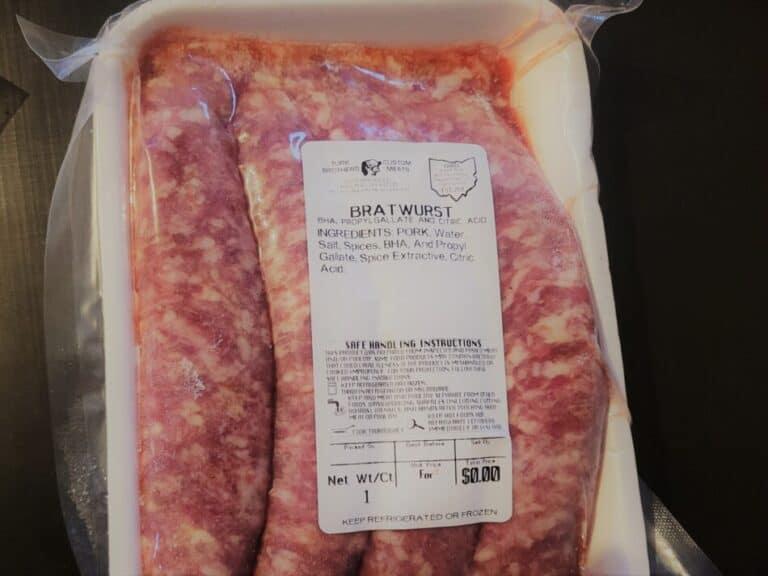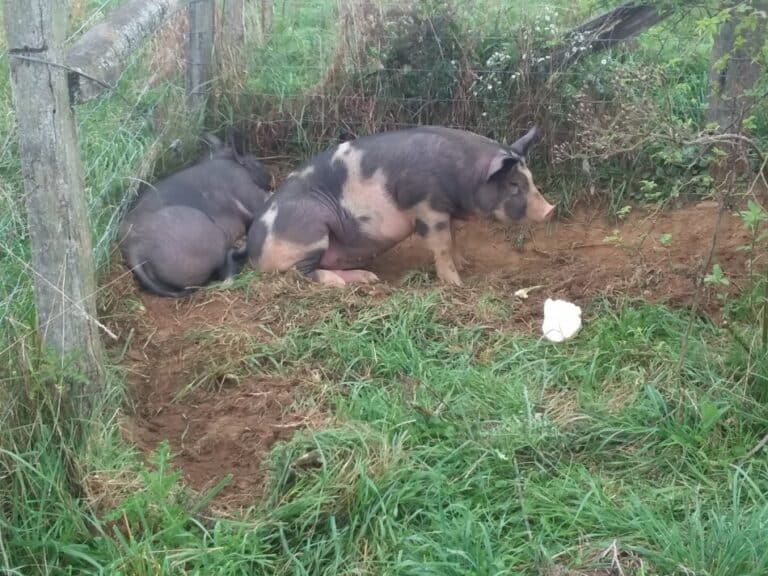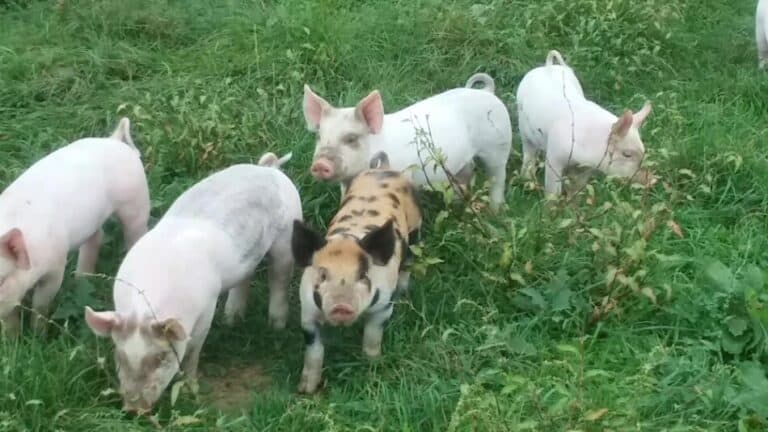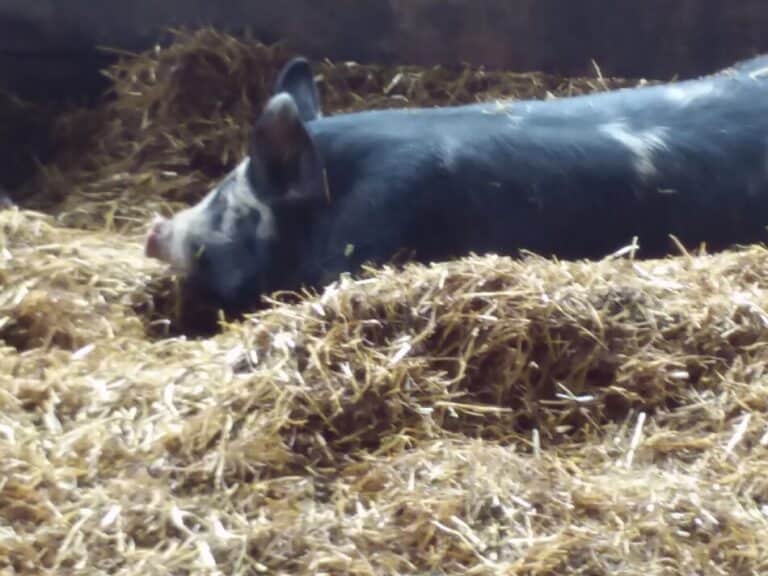Choosing The Best Pig Breed For Meat
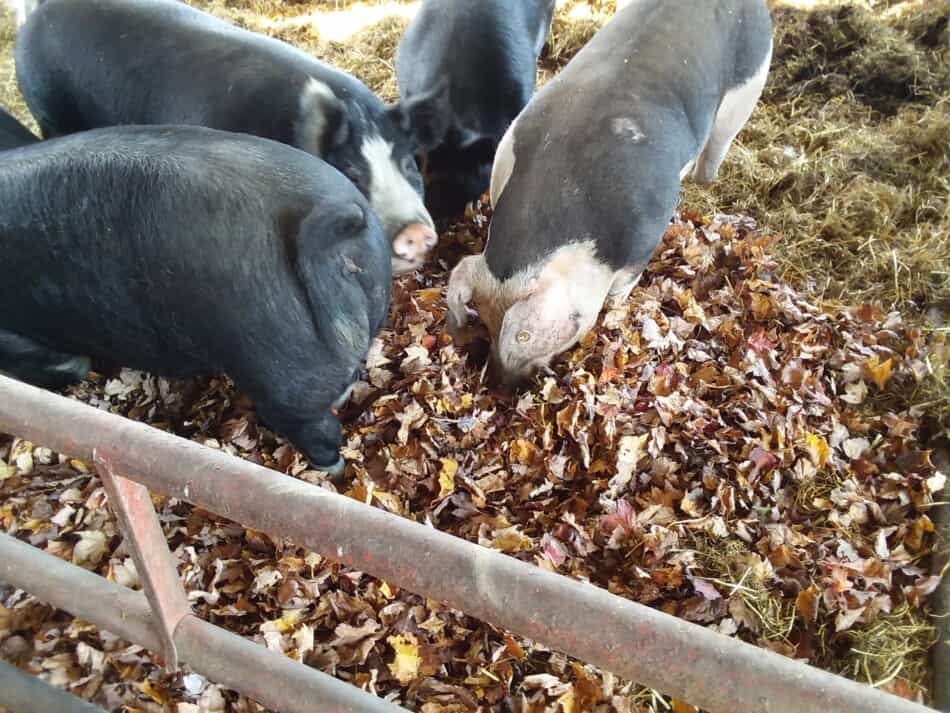
Nothing beats homegrown pork for flavor and peace of mind! Once that freezer is full, can be sure your family is going to eat well this year.
Not to mention the cost savings when you raise your own pigs! Here’s the big question-what breed of pig to get?
The best breed of pig for meat is a meat specific breed or cross of breeds, including Hampshire, Duroc and/or Berkshire. These breeds of pigs are selected for superior carcass traits and growth, which give you more meat per finished pig.
First off, let’s get to the bottom line here-all pigs have meat as their ultimate purpose. Any pig breed of nearly any age can be, and probably is somewhere, used for meat.
This is good news! It means that you really can’t go wrong when you pick a breed of pig. However, if you are looking for specific meat or carcass traits there are differences between breeds.
Is Raising Pigs For Meat Worth It? will walk you through making a budget for your pigs so you can see what your pigs will cost and determine if raising your own pork is worth it to you.
Note: some areas of the U.S. seem to have all kinds of pigs (you will have it easy finding pigs) and other areas are mostly pig free (this group will have to travel).
There are meat specialist pig breeds
These are breeds of pigs that still are being extensively used in commercial pig operations, chosen for their efficiency of gain and meat production qualities.
To give you an example: the two black gilts (female pigs that are not moms yet) pictured above are 3/4 Berkshire pigs that I have kept for breeding stock.
They were selected for meat qualities, specifically fast growth and a wide, meaty body.
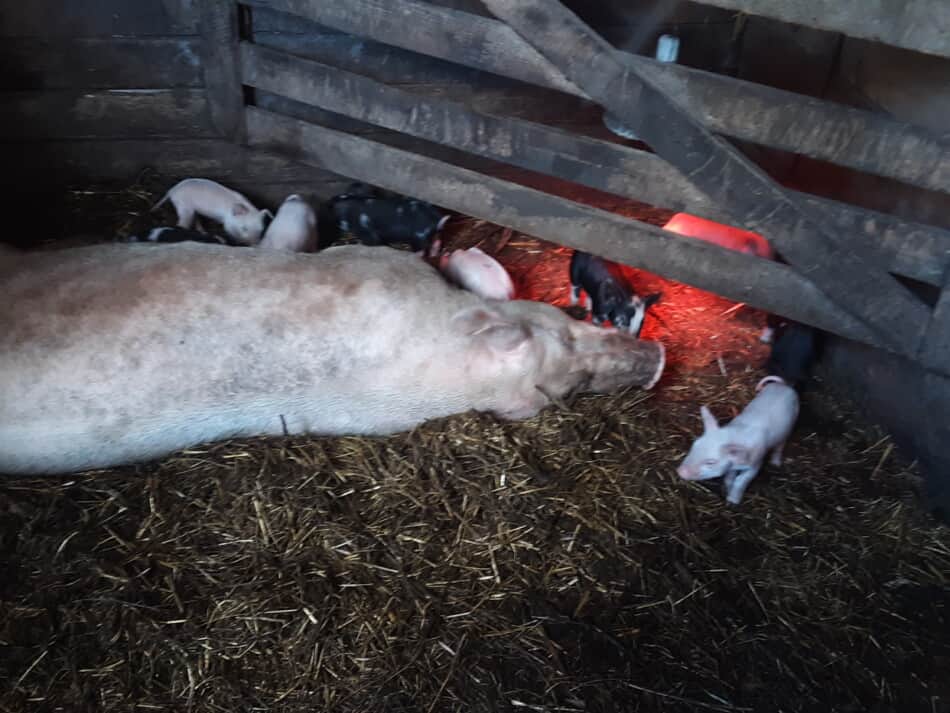
Get pigs from commercial meat breeds
If you are new, start with pigs from this group.
They are likely to be the easiest ones for you to find and the most likely to turn out well for someone new to pigs.
Note: Yorkshire is in the “Do It All” section, since they are actually a maternal breed, but they would make a great meat pig choice, as well.
How Fast Do Pigs Grow? 5 Keys To Success and When To Get A Feeder Pig are both articles I wrote to give the new pig enthusiast some help getting started.
Duroc pigs are known for growth
- Red pig with drooping ears
- Second most popular breed in the U.S.
- Known for carcass yield, fast growth and efficient gains
Hampshire pigs are known for lean muscling
- Black pig with a white belt, upright ears
- Fourth most popular breed in the U.S.
- Known for lean muscle and large loin eye (big pork chops)
Berkshire pig are known for meat flavor
- Black pig with upright ears and white points (nose, feet, tail)
- Third most popular breed in the U.S.
- Known for meat flavor and value
Crossbred pigs have hybrid vigor
- Very common pig, especially feeder pigs
- Hardy due to hybrid vigor
- Will get the best of each parent breed in one pig
- Most likely type of feeder pig to be available for purchase at auction
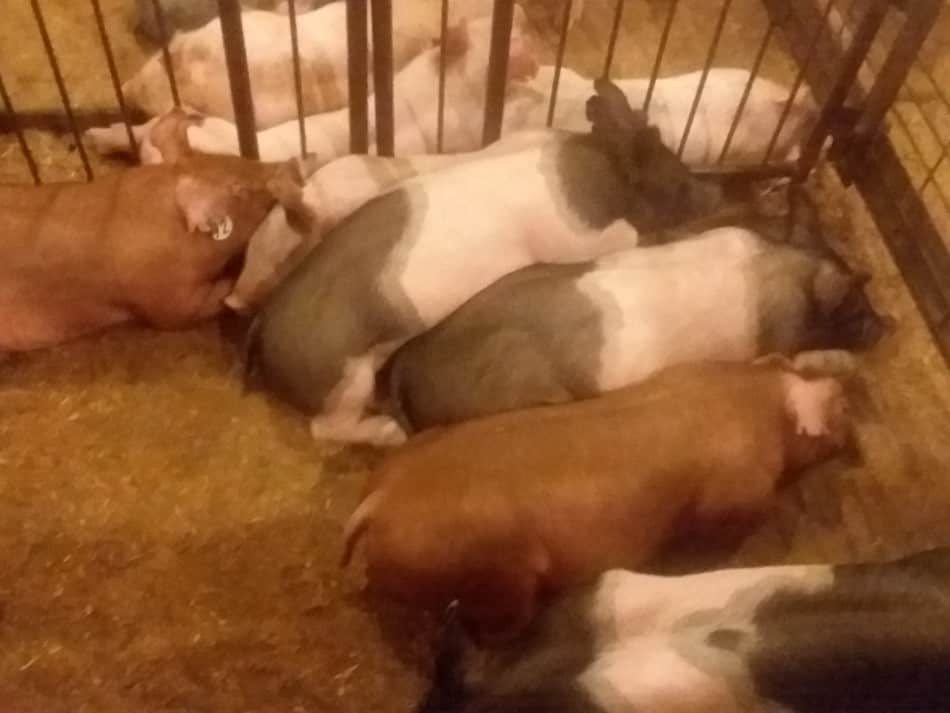
There are “Do It All” pig breeds
This section has breeds that were common, before the huge push for CAFO (confinement animal feeding operation) produced pork, at least in specific area of the country.
For instance: the Chester White being super popular in Pennsylvania and the Poland China being very popular in Ohio, the states where each originated.
As huge commercial hog operations took over the vast majority of pork production in the U.S., the pig breeds that were not chosen to be used in the confinement hog operations fell out of favor with farmers.
The numbers of these pigs being raised plummeted as a result.
The exception to this lowered population is Yorkshire. Yorks emerged as the premier pig for the modern (industrial) hog farmer, still maintaining that rank today.
This is no fault of the breed, just that the characteristics of that breed did not match up as well as another breed for CAFO pig production, except for the Yorkshire, which seems to excel no matter where they are raised.
The less common pig breeds are the hidden gems of the pig world. They are going to be very small farm/homesteader friendly pigs.
If you are fortunate enough to live near a farmer who raises one of these breeds, consider yourself lucky and get them!
Chester Whites are homesteader gold
- Medium size white pigs with drooping ears
- Known for muscle quality and durability
- Great breeding stock choice for a homesteader or small farmer
Poland China known for their gains
- Large Black pig with drooping ears and white points
- Quiet disposition
- Known for leanness, muscle and good gains
Spotted pigs are efficient gainers
- Black pig with large white spots
- Known for feed efficiency and rate of gain
- Docile and durable, great choice for beginning pig raiser
Yorkshire pigs are muscular and lean
- White pig with upright ears
- Most popular breed in the U.S.
- Known for muscling and lean meat
Looking for another source of pictures and breed characteristics? Check out the University Of Kentucky Swine Discovery Breeds List, just click on the breed you are interested in for more breed specifics.
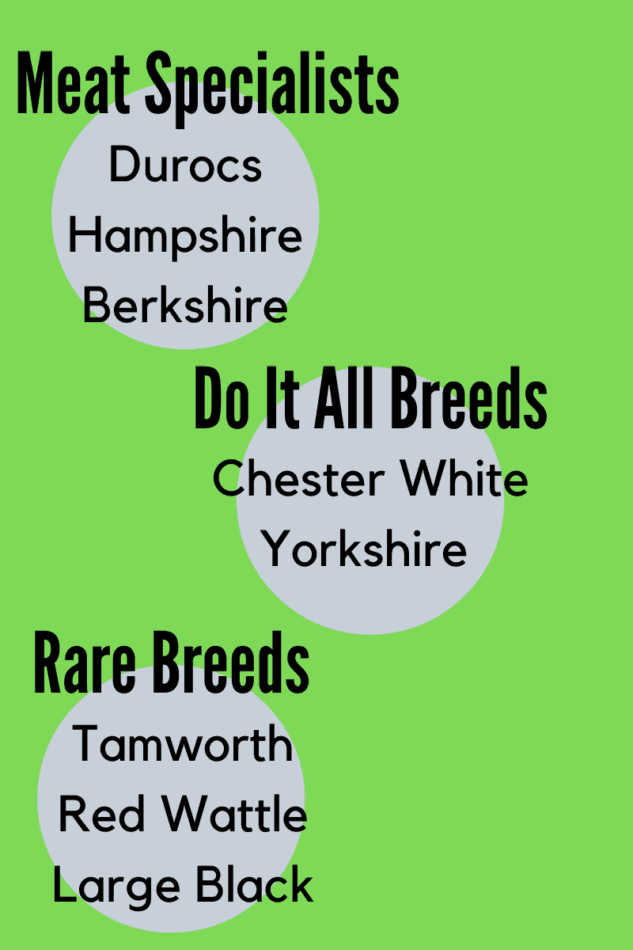
Rare breed pigs are available
Maybe you are wondering if getting a few piglets of a more unusual breed would be a good fit for you and your family?
This section of the list is for breeds of pigs you may have heard of in doing some research yet might not know much about them.
Depending upon how much you are into breeds of pigs and their attributes, you might not have heard of these breeds at all.
The more rare breeds are the pigs that small farmers who are looking to set themselves apart from the rest, generally to sell privately or at farmer’s markets, are raising.
These pigs have traits that make them a bit different than the pigs listed above, traits that are not appreciated by commercial hog producers.
Read: they are cool, but take longer to raise, or don’t economically put on weight, etc.
Don’t be surprised if getting a few of these more unusual breed piglets, or even breeding stock, sets you back quite a bit more than purchasing a more common breed of pigs.
They are harder to get, but becoming more popular now, the word is getting out!
That means prices are going to be higher. But, if you want something special in your pigs, then go for it.
Please note that flavor is more a result of diet than breed.
If you have eaten pork of a specific breed and you decided to raise some yourself, first off-good for you!
Second, you’ll need to feed your pigs the same way the other people fed their pigs to get the same results.
*This is not a full list, just a few to give you the idea.*
Red Wattle pigs are all American
- Red pig with a wattle (dangling tube-shaped skin) on each side of head
- Active, outdoor pig
Mangalitsa/Mangalica pigs have lots of fat
- Also called Wooly pig
- Known for huge amounts of fat surrounding the meat
Guinea hogs are smaller sized pigs
- Black pig, very round with short nose
- Much smaller sized pig than others on the list, mature weight of 300 pounds
- Originally a forest pig, another name is the Acorn Eater
Tamworth pigs are active and friendly
- Orange/red pig with long nose and long body
- Active, good outside
Large Black pigs are known for mothering ability
- large sized all black pig with drooping ears
- Known for mothering ability
If you are wanting more information on any of these rare breeds of pigs the best place to start is The Livestock Conservancy.
They have a great list of all the rare breeds and descriptions of each breed, including mature weights and characteristics that make these breeds so interesting.
I didn’t go into much detail with these pigs since they are harder to find, so it is less likely they will be an option for you.
If you have some pig raising experience and want to market and raise something special, a rare breed is a super choice. They are not for everyone, but what is?
Resources: pork.org pork checkoff


